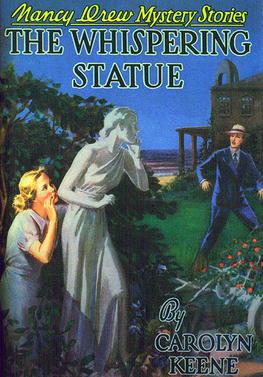The Whispering Statue facts for kids

Original edition cover
|
|
| Author | Carolyn Keene |
|---|---|
| Illustrator | Russel H. Tandy |
| Cover artist | Russell H. Tandy |
| Country | United States |
| Language | English |
| Series | Nancy Drew Mystery Stories |
| Genre | Juvenile literature |
| Publisher | Grosset & Dunlap |
|
Publication date
|
1937, 1970 |
| Media type | Print (Hardback & Paperback) |
| Pages | 179 |
| ISBN | 0-448-09514-9 |
| OCLC | 514896 |
| LC Class | PZ7.K23 Nan no. 14 1970 |
| Preceded by | The Mystery of the Ivory Charm |
| Followed by | The Haunted Bridge |
The Whispering Statue is the fourteenth book in the exciting Nancy Drew Mystery Stories series. It was written by Mildred Wirt Benson, who many readers think was the best writer for the series. The story was first published in 1937. Later, a new and different version of the story came out in 1970, but it kept the same title.
The Original Mystery: 1937 Story
Nancy, Bess, and George are heading to a park opening. On their way, they meet a playful stray dog. This dog, a terrier, grabs a speaker's handbag. It then drops the bag into a nearby pond. Nancy helps get the bag back. Inside, she finds notes that help the nervous speaker. She also finds a strange personal ad.
A woman named Mrs. Owen tells Nancy about a statue. It's on a lonely seaside estate. This statue is called "The Whispering Girl." It looks a lot like Nancy! Coincidentally, Nancy is already planning to visit that very area. She will go with her father and her friends, Bess and George.
Nancy decides to keep the terrier for a while. She names him Togo, after a famous sled dog. Togo follows her to the train station. Nancy has no choice but to bring him to Sea Cliff. On the train, the girls see an odd old woman, Miss Morse. They suspect a man is trying to trick her.
Once in Sea Cliff, the girls search for the statue. They also look for Miss Morse. Nancy is curious about her and wants to help. Things get more mysterious when Miss Morse says she is being tricked. But she tells Nancy to leave it alone. Nancy then overhears the trickster boasting about his plan.
Nancy meets some quirky but helpful older men. A seaplane accident happens. Nancy rescues a client of her father's. This client is connected to both Mrs. Owen and Miss Morse. In the story's big ending, Nancy hides behind the statue. She uses her voice to make the statue seem to talk to the con man. She gets captured and tied up. As she faces one of the bad guys, the mansion on the cliff falls into the ocean! This leads to another dramatic rescue.
This 1937 book is known for having many characters and lots of coincidences. However, it also introduces Togo, the dog. Togo becomes a popular character in many future Nancy Drew books.
A New Adventure: The 1970 Story
In the 1970 version, Nancy is asked to solve two mysteries. The first mystery is about a valuable collection of rare books. A wealthy woman, Mrs. Horace Merriam, hired an art dealer to sell them. But she now thinks he is a swindler. She believes he is not giving her the money she is owed.
The second mystery involves a beautiful marble statue. This statue is believed to "whisper." It also looks a lot like Nancy! The statue has been mysteriously stolen. Nancy goes undercover to work for the art dealer. She uses the fake name Debbie Lynbrook.
The mystery gets more complicated. The marble statue is returned, but it's a fake! Nancy faces many exciting challenges. There's an attempted kidnapping. A sailboat nearly crashes. She also meets a dishonest sculptor. Nancy gathers clues against a clever group of art thieves.
The Art of the Mystery
The original cover art for the 1937 book was done by Russell H. Tandy. It shows Nancy hiding behind a statue, talking to a man. Rudy Nappi drew the same scene for the 1962 cover. He updated the clothing and hairstyles to look more modern. Nappi also illustrated the cover for the 1970 edition. This cover is mostly blue and white. It shows Nancy's profile with a statue in the background.

